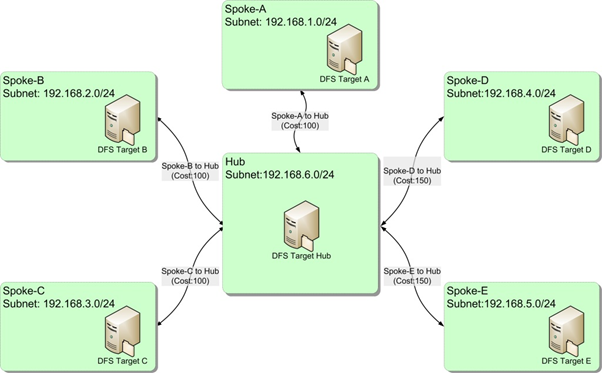DFS Override Referral Ordering, Messing with the Natural Order
Hi everyone. This is your friendly (debatable) PFE, Mark Renoden again. Today I’m talking about DFS Override Referral Ordering – a seldom-used feature with an interesting benefit. For the purpose of this discussion, I’ll refer to the following Active Directory Site Diagram:
For the entire discussion, let’s suppose our client is in the site Spoke-A and is accessing a DFS Folder target
Referral Configuration
DFS Namespaces allow three options for the ordering of referrals. These are available in the Properties page of the namespace (and optionally overridden using the properties page of individual DFS folders)
Note the highlighted text. DFS referrals list DFS targets in the same site as the client, first. As an administrator, you have the option to return DFS targets outside the client’s site in random order, by lowest cost or not at all. The last option – Exclude targets outside of the client’s site – is also known as INSITE.
To see an explanation of Active Directory Site Topology impact on DFS referrals, look here.
I’m going to ignore “Random order” in this discussion. It’s self-explanatory – your DFS referral list for targets outside the client site is random (huh, I just explained it).
Referrals Returned by Lowest Cost
Assume I’ve configured my namespace to return referrals by lowest cost. For my client residing in site Spoke-A, the DFS referral process will offer the ordered list:
DFS Target A
DFS Target Hub
<random ordering of DFS Target B and DFS Target C>
<random ordering of DFS Target D and DFS Target E>
Site Hub has a total cost of 100 from site Spoke-A and is listed first in the out-of-site order.
Sites Spoke-B and Spoke-C have a total cost of 200 from site Spoke-A and are randomly listed next.
Sites Spoke-D and Spoke-E have a total cost of 250 from site Spoke-A and are randomly listed last.
DFS Override Referral Ordering
Now let’s look at the setting we’ve all come to see. DFS Override Referral Ordering is a property set on a DFS target. This could be a DFS Namespace server or a DFS Folder target.
I’ll walk through the effects of each option shown here when set on DFS Target B.
First Among All Targets
The DFS referral process will offer the ordered list:
DFS Target B
DFS Target A
DFS Target Hub
DFS Target C
<random ordering of DFS Target D and DFS Target E>
Last Among All Targets
The DFS referral process will offer the ordered list:
DFS Target A
DFS Target Hub
DFS Target C
<random ordering of DFS Target D and DFS Target E>
DFS Target B
First Among Targets of Equal Cost
The DFS referral process will offer the ordered list:
DFS Target A
DFS Target Hub
DFS Target B
DFS Target C
<random ordering of DFS Target D and DFS Target E>
Last Among Targets of Equal Cost
The DFS referral process will offer the ordered list:
DFS Target A
DFS Target Hub
DFS Target C
DFS Target B
<random ordering of DFS Target D and DFS Target E>
As you can see, these options give predictable results. Now for the cool bit …
INSITE + DFS Override Referral Ordering
As I mentioned earlier, INSITE (or Exclude targets outside of the client’s site) will cause the DFS referral process to offer only:
DFS Target A
If we combine this with DFS Override Referral Ordering set to Last Among all Targets on DFS Target Hub, the DFS referral process will offer:
DFS Target A
DFS Target Hub
In other words, our local target first and the hub target second with no other out of site referrals. This would be desirable in environments where the network is not fully routable with client connectivity limited to the local site and the hub site.
If more than one target has DFS Override Referral Ordering set to the same value, those targets will be returned in random order at the appropriate point in the referral list (i.e. site costing is ignored for those targets with override settings). For example, if DFS Target Hub and DFS Target B were configured with DFS Override Referral Ordering set to Last Among all Targets in combination with INSITE, the DFS referral process will offer:
DFS Target A
<random ordering of DFS Target Hub and DFS Target B>
Lastly, First/Last Among Targets of Equal Cost have no effect when INSITE is set.
Conclusion
DFS Override Referral Ordering has some interesting applications and allows you to steer clients to targets in environments where site-costed referrals are not ideal.
- Mark “Be Glad I’m not a Geneticist” Renoden


